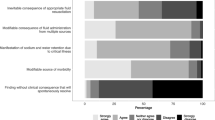Abstract
This paper reviews the reported use of nonopioid medications for terminal sedation. To provide a summary of the available literature, an electronic database search was performed. Thirteen series and 14 case reports were identified. Various symptoms, including agitation, pain, and confusion, required terminal sedation. Eleven drugs were used in 342 patients. Most patients were also treated with concurrent opioids and received terminal sedation in an inpatient hospice unit. Midazolam was the most common sedative employed. A good response – defined as adequate sedation – ranged between 75% and 100%. The median time to death following the introduction of terminal sedation was greater than 1 day. No agent appears to have superior efficacy or limiting toxicity.
Similar content being viewed by others
Author information
Authors and Affiliations
Additional information
Electronic Publication
Rights and permissions
About this article
Cite this article
Cowan, J.D., Walsh, D. Terminal sedation in palliative medicine – definition and review of the literature. Support Care Cancer 9, 403–407 (2001). https://doi.org/10.1007/s005200100235
Published:
Issue Date:
DOI: https://doi.org/10.1007/s005200100235




